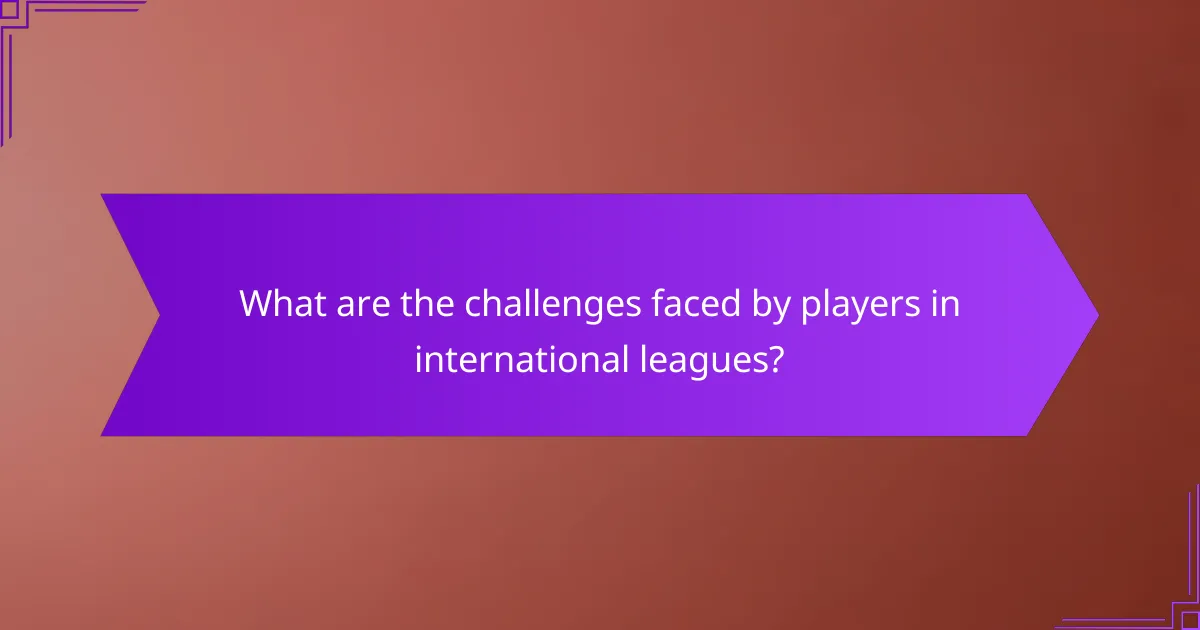International leagues play a pivotal role in shaping player careers by providing enhanced visibility and financial opportunities. These leagues not only allow athletes to demonstrate their talents on a global platform but also facilitate career advancements through lucrative contracts and diverse pathways for recognition. Additionally, they contribute to youth development and scouting, impacting the future of sports worldwide.

How do international leagues impact player careers?
International leagues significantly enhance player careers by providing greater visibility, financial incentives, and unique experiences. These leagues create pathways for athletes to showcase their skills on a global stage, often leading to lucrative contracts and diverse opportunities.
Increased visibility and exposure
Playing in international leagues allows athletes to gain substantial visibility, attracting attention from scouts, sponsors, and fans worldwide. This exposure can lead to increased media coverage and social media following, which can enhance a player’s marketability.
For example, a player in a top European league may receive offers from clubs in other countries, expanding their career options and potential fan base. The more visible a player is, the more opportunities arise for endorsements and partnerships.
Access to higher salaries
International leagues often offer significantly higher salaries compared to domestic leagues, especially in regions like Europe and North America. Players can negotiate contracts that reflect their talent and market demand, sometimes earning millions annually.
For instance, players in the English Premier League or Major League Soccer can command salaries in the high six or even seven figures. This financial boost not only improves their quality of life but also allows them to invest in their future.
Opportunities for international experience
Playing in international leagues provides players with invaluable experience in different cultures and playing styles. This exposure can enhance their adaptability and skill set, making them more versatile athletes.
For example, a player moving from a South American league to a European league may learn new tactical approaches and techniques, which can improve their overall performance. Such experiences can also enrich their personal growth and global perspective.
Networking with global talent
International leagues facilitate connections with a diverse range of players, coaches, and industry professionals. Networking in these environments can lead to future collaborations, mentorship opportunities, and career advancements.
Players often build relationships that extend beyond their current teams, which can be beneficial for career longevity. Engaging with global talent can also open doors for post-career opportunities in coaching, management, or sports media.

What opportunities do international leagues provide?
International leagues offer players a chance to showcase their skills on a global stage, leading to career advancements and financial rewards. They create pathways for talent to be recognized by top clubs, while also fostering youth development and providing scouting avenues for agents.
Pathways to top clubs
International leagues serve as vital pathways for players aiming to join elite clubs. By competing at a high level, players can attract the attention of scouts from prestigious teams, often leading to lucrative contracts. For example, a standout performance in a European league can result in opportunities in the Premier League or La Liga.
Players should focus on consistently improving their skills and maintaining strong performances to maximize their visibility. Networking with agents and participating in international tournaments can further enhance their chances of being noticed by top clubs.
Development programs for young players
Many international leagues have established development programs aimed at nurturing young talent. These programs often include training academies that provide coaching, mentorship, and competitive opportunities. For instance, leagues in countries like Germany and Spain are renowned for their youth academies that have produced world-class players.
Young players should seek out leagues that prioritize development and offer structured training environments. Engaging in local competitions and showcasing talent at youth camps can help in gaining entry into these programs.
Scouting opportunities for agents
International leagues present significant scouting opportunities for agents looking to represent emerging talent. Agents can identify potential clients by attending matches and evaluating players in various leagues. This exposure allows them to build a diverse portfolio of athletes from different regions.
Agents should stay informed about league dynamics and player performance trends to make informed decisions. Building relationships with club scouts and attending international tournaments can also enhance their scouting effectiveness.

How do international leagues compare in terms of player development?
International leagues vary significantly in their approach to player development, with some offering more structured pathways and resources than others. Factors such as coaching quality, competition level, and financial investment play crucial roles in shaping players’ careers across different regions.
Major League Soccer (MLS) vs. European leagues
Major League Soccer (MLS) has made strides in player development, but it often lags behind European leagues in terms of competition intensity and resources. European leagues, particularly in countries like England, Spain, and Germany, provide a more rigorous environment with established youth academies and a higher level of play, which can accelerate player growth.
MLS has been focusing on improving its academies and attracting international talent, yet players may find that the competitive edge in Europe offers more opportunities for exposure and advancement. For example, players in European leagues often have access to better training facilities and more experienced coaching staff.
Asian leagues and player growth
Asian leagues, such as the Chinese Super League and J-League, are increasingly investing in player development, but they face challenges in terms of competition and infrastructure. While leagues like the J-League have a strong reputation for nurturing local talent, others may struggle to provide the same level of opportunity.
In countries like Japan and South Korea, youth development programs are robust, leading to a steady stream of skilled players. However, the overall competitiveness of Asian leagues can vary, impacting players’ growth and exposure on the international stage.
South American leagues’ influence
South American leagues, particularly those in Brazil and Argentina, are renowned for their ability to develop world-class talent. The emphasis on technical skills and creativity in these leagues often produces players who excel in international competitions.
Clubs in South America frequently sell players to European teams, providing a pathway for young athletes to advance their careers. The competitive nature of leagues like the Argentine Primera División fosters a challenging environment that can significantly enhance a player’s abilities and marketability.

What are the financial implications of playing in international leagues?
Playing in international leagues can significantly impact a player’s financial situation, offering varying salaries, endorsement deals, and transfer fees. Understanding these implications is crucial for players considering their career paths and potential earnings.
Salary differences across leagues
Salary structures vary widely across international leagues, influenced by factors such as the league’s popularity, broadcasting rights, and overall revenue. For instance, top leagues in Europe, like the English Premier League or La Liga, often offer salaries in the millions, while players in smaller leagues may earn significantly less, sometimes in the low tens of thousands annually.
Players should research the average salaries in their target leagues to gauge potential earnings. Additionally, consider the cost of living in the respective countries, as this can affect disposable income. For example, a high salary in a country with a high cost of living may not stretch as far as a lower salary in a more affordable locale.
Endorsement opportunities
Endorsement deals can be a substantial source of income for players in international leagues, particularly those in high-profile leagues. Players with strong marketability can secure contracts with brands, ranging from sports apparel to lifestyle products, which can sometimes exceed their playing salaries.
To maximize endorsement potential, players should focus on building a personal brand through social media and community engagement. Networking with agents and marketing professionals can also lead to lucrative partnerships. However, players should be cautious of overextending themselves with too many endorsements, which can dilute their brand and impact their on-field performance.
Transfer fees and market value
Transfer fees represent a significant financial aspect of a player’s career in international leagues, often reflecting their market value. High-performing players can command transfer fees in the millions, while those in less competitive leagues may see lower valuations.
Players should be aware of their market value and how it can fluctuate based on performance, age, and demand. Keeping track of trends in player transfers can provide insights into potential future earnings. Additionally, players should consider the implications of transfer fees on their contracts and negotiations, as clubs often factor these fees into their financial planning.

How do international leagues influence global football culture?
International leagues significantly shape global football culture by introducing diverse playing styles, fostering local fan engagement, and facilitating cross-cultural interactions among players. These elements contribute to a richer, more inclusive football experience worldwide.
Promotion of diverse playing styles
International leagues showcase a variety of playing styles that reflect the cultural backgrounds of their players and coaches. For instance, leagues in Spain may emphasize possession and technical skill, while leagues in England often prioritize physicality and pace. This diversity encourages players to adapt and learn from different approaches, enhancing their overall skill set.
As players from various countries compete in these leagues, they bring unique techniques and strategies that can influence local teams and inspire grassroots development. Clubs may adopt elements from different styles, leading to a more varied and dynamic football landscape.
Impact on local fan engagement
International leagues create opportunities for local fans to engage with a broader football community. Fans can support their favorite players from around the world, which fosters a sense of connection and excitement. For example, when a popular foreign player joins a local club, it often boosts attendance and merchandise sales, reflecting increased fan interest.
Moreover, international tournaments and league matches broadcast worldwide allow fans to experience different football cultures, enhancing their appreciation for the sport. Local fan clubs often organize events to celebrate these matches, further strengthening community ties.
Cross-cultural player interactions
International leagues facilitate cross-cultural interactions among players, which can lead to lasting friendships and professional networks. These interactions help players learn about different cultures and perspectives, enriching their personal and professional lives. For instance, teammates from different countries often share insights about their footballing philosophies and lifestyles.
Additionally, these interactions can promote tolerance and understanding, as players collaborate and compete with individuals from diverse backgrounds. This cultural exchange not only benefits the players but also influences fans, who may adopt a more global view of football and its significance.

What are the challenges faced by players in international leagues?
Players in international leagues encounter various challenges, including cultural adaptation and communication hurdles. These obstacles can significantly impact their performance and overall experience in a new environment.
Adapting to new environments
Adapting to new environments is crucial for players in international leagues. This includes adjusting to different playing styles, training regimens, and team dynamics. Players often need to quickly learn about local customs and social norms to integrate effectively.
For example, a player moving from a European league to a league in Asia may find that the training intensity and match schedules differ significantly. Understanding these nuances can help players acclimate faster and perform better on the field.
Language barriers
Language barriers pose a significant challenge for players in international leagues, affecting both on-field communication and off-field interactions. Misunderstandings can occur during training sessions, impacting teamwork and strategy execution.
To overcome language barriers, players can engage in language courses or use translation apps. Establishing a rapport with bilingual teammates can also facilitate smoother communication, enhancing both personal and professional relationships.



